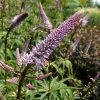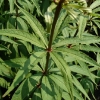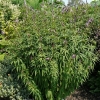Features
A tall, herbaceous perennial which has long stems adorned with whorls of long, mid green leaves and topped with long spires of small, lavender coloured flowers in summer.
What to use it for
Great for towards the back of borders, particularly in prairie style planting schemes, although it’s equally at home in cottage style gardens. Useful for cut flowers and to attract bees and butterflies.
How to look after it
Keep well watered in dry weather. The tall stems may require support if grown in particularly windy locations.
In spring apply a mulch of garden compost or well rotted farmyard manure around the base of the plant.
Rejuvenate congested clumps by dividing them in spring.
How to prune it
Remove the flower spikes as they fade. Cut the plant down to ground level in autumn when flowering has finished.
How to propagate it
Divide clumps in the spring or take basal stem cuttings in late spring from 10cm long shoots and keep at 15°C until rooted (which takes about 2 weeks).
Alternatively you can collect seeds and sow them in the spring at 15°C. However, as this is a cultivar it may not set seed and any seeds you do collect are unlikely to come true to type.
Common problems
Generally speaking Veronicastrum plants are not bothered by pests. However, downy mildew, powdery mildew and leaf spots may be a problem.
Other useful information?
Veronicastrum virginicum was used by Native Americans as a purgative, to induce vomiting. It is still used today in homeopathic remedies for liver complaints.
This plant used to be classified within the genus Veronica, however it has now been moved into its own group due to its distinctive leaf and flower arrangements.







